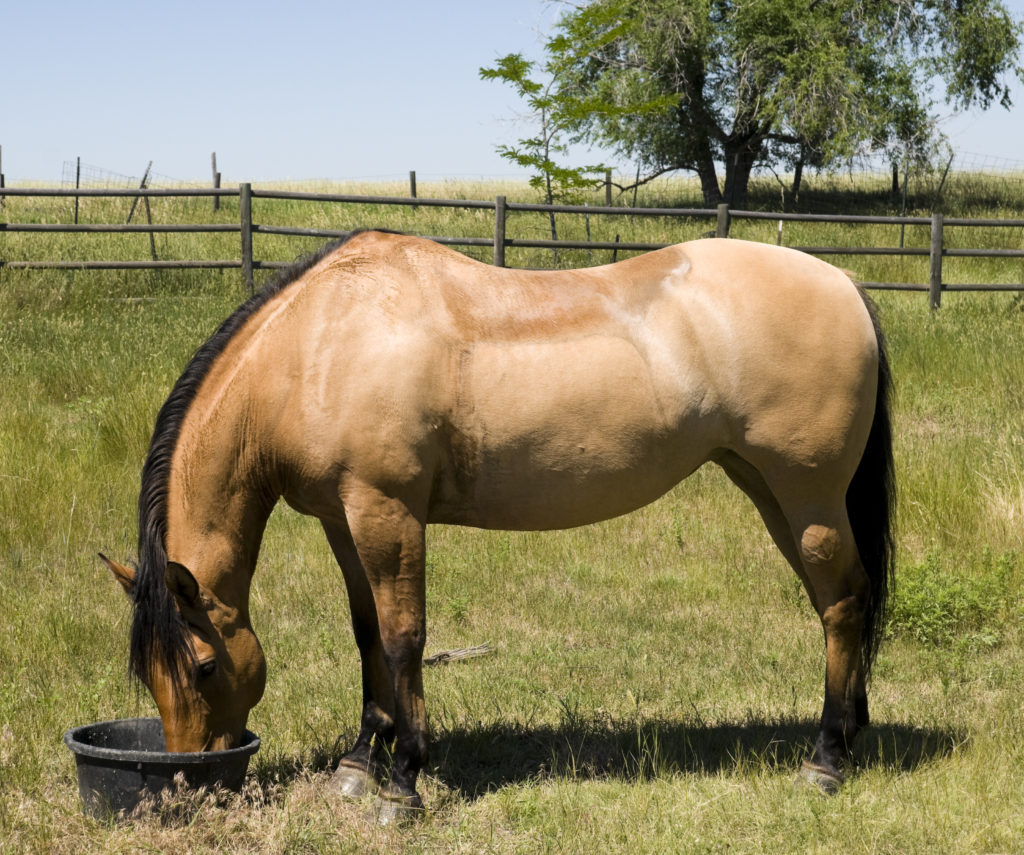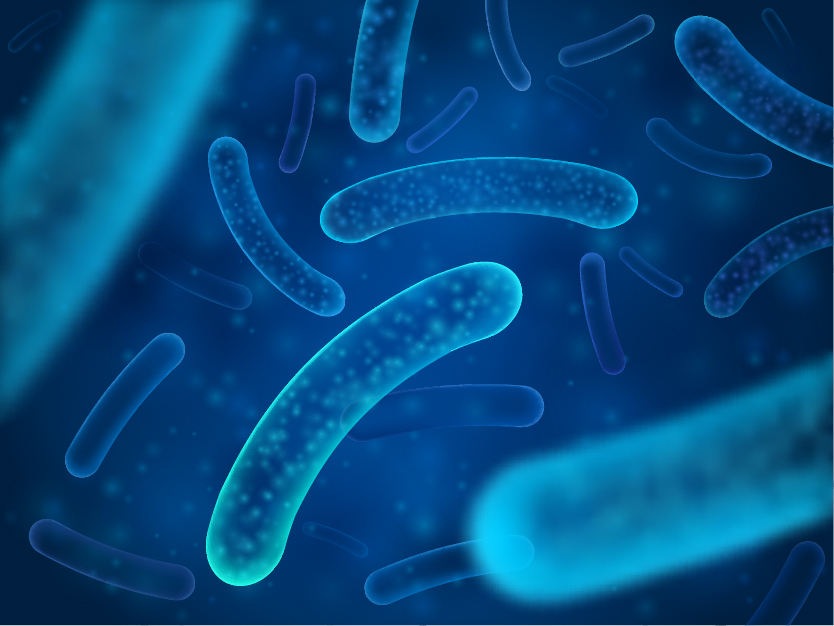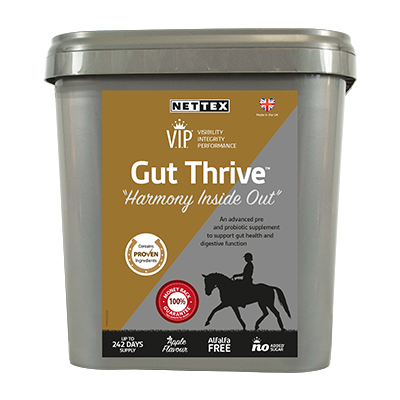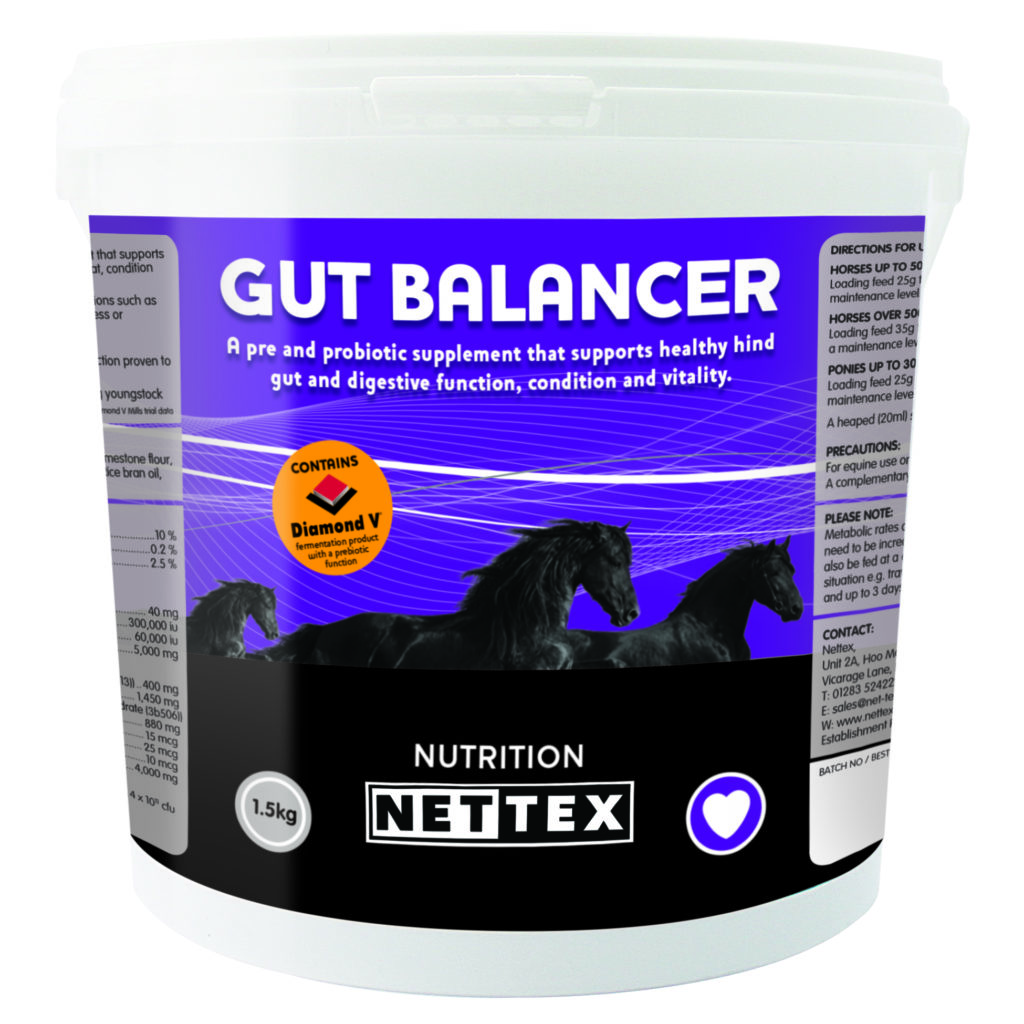Pre and Probiotics for Horses
Pre and probiotics in equine nutrition
By Chesney Webb, BSc (Hons) (Equine Science), ACIM, Nutritional Advisor, Part of Nettex’s trusted team of experts and nutritionists.
As owners have become more aware of their horse’s nutritional needs to support their intricate digestive system, providing the perfect hindgut environment is a top priority for horse owners to help reduce the risk of conditions such as colic and diarrhea. Owners commonly choose to supplement their horses’ diets with pre and probiotics, but why are these helpful?
First things first, fibre. Fibre should make up the largest portion of a horse’s diet and is digested in the hindgut. The digestion of fibre is not a short process – it can take up to three days for the fibrous material to pass through the three main sections of the hindgut: the caecum, large colon and small colon. The environment within the caecum and colon is a critical factor for the digestion and absorption of nutrients from fibrous products such as hay and beet pulp. Although horses rely on a high fibre diet, they do not have the enzymes needed to break down the fibre into nutrients. For this, they depend on micro-organisms in their hindgut known as microbes. These microbes, which include bacteria (‘good bacteria’) and yeast, digest fibre via fermentation and break down fibre into volatile fatty acids which are absorbed through the large intestine. The microbes and this process are important for the horse as it provides energy, helps to maintain gut movement and acts as a barrier against harmful bacteria.
For fibre digestion to be efficient, it relies on a healthy microbe population in the hindgut. A healthy gut makes a healthy horse and the delicate balance of these microbes can be easily affected by abrupt changes to the horse’s diet, stress or medication. Disruption of the microbes can lead to health problems such as colic or diarrhoea. As the ‘good’ bacteria die and release harmful endotoxins into the bloodstream, the ‘bad’ bacteria are able to multiply, resulting in ill health.

What are probiotics?
These are live micro-organisms or ‘good’ bacteria that enhance the horse’s hindgut microbial population and reduce the growth of potentially harmful bacteria. Probiotics may include bacteria such as Lactobacillus acidophilus, Streptococcus faecium, and Bacillus subtilis; fungi such as Aspergillus oryzae; and yeast strains such as Saccharomyces cerevisiae. Included in a feed mix in powdered or granulated form, probiotics continually introduce beneficial organisms that may be depleted by daily management. At times when the horse is under particular stress because of travelling, illness, or a busy performance schedule, they may be administered as oral pastes, gels, or liquids.
For example, probiotics are reported to:
- Facilitate immunomodulation by keeping the host immune system primed to respond more quickly and effectively to infection.
- Improve gut health in patients with inflammatory bowel diseases.
- Help prevent antibiotic-induced diarrhoea.
- Protect against infectious agents that cause diarrhoea, such as Salmonella spp.
A commonly used probiotic is the yeast strain Saccharomyces cerevisiae, intended to help keep horse’s ‘good’ microbe population healthy. Probiotics are measured in CFUs (or colony forming units), which effectively shows us the number of live cells that can multiply and is a way to compare one probiotic to another successfully.
What are prebiotics?
Prebiotics are essentially ‘food’ for the good bacteria. These are food components that stimulate hindgut microflora activity and growth. Prebiotics are not digestible and can’t be utilised by the horse itself but help to maintain a healthy gut flora and limit the number of harmful microbes. These are carbohydrate fibres, and the most commonly used prebiotics in horses are fructo-oligosaccharrides (FOS) and manno-oligosaccarides (MOS). Yeast is a commonly used for its prebiotic function, it is full of amino acids and oligosaccharides that nourish desirable bacteria. There is also evidence that some prebiotics enhance the equine immune system.
How do prebiotics work?
The microorganisms within the gut attach themselves to the gut wall and reproduce in the correct conditions. It is therefore important that it is the good bacteria and not the harmful type, that binds to these sites. The prebiotic MOS helps to ensure this by ‘mopping up’ the harmful bacteria and removing it from the digestive tract before it can attach to the gut wall.
FOS, however, are chains of fructose units naturally found in some foods, including sugarbeet. FOS provides a food source for the good bacteria in the hindgut to encourage their growth over bad bacteria, such as E. coli that can’t utilise FOS.
Pre and probiotics are most effective when fed together (known as Synbiotics). By supporting optimal digestive health, they also provide support for the immune system.

Will digestive aids help your horse?
Very little research has been done on the use of probiotics in equines, with the exception of yeast. However, studies have shown that probiotics are beneficial to humans and other species. Research with horses has shown that live yeast culture supplementation helps to limit undesirable change to the delicate hindgut by reducing variations in lactic acid concentration and pH levels – especially after large grain meals. Yeast has also been proven to be beneficial for growing horses, increasing the digestibility of ADF (Acid Detergent Fibre) and NDF (Neutral Detergent Fibre), calcium, phosphorus and zinc.
Digestive aids such as pre and probiotics are beneficial for horses who are sensitive to changes in their diet or are of a stressed disposition. For those horses, digestive aids would be recommended daily. If a horse usually has firm droppings, is healthy and of good weight, but is temporarily undergoing a feeding change or having antibiotic treatment, feeding pre and probiotics for this short term can really benefit.
Supplementation of pre and probiotics can have positive effects on horses. When choosing a product look out for ingredients such as Saccharomyces Cerevisiae, Brewer’s yeast, encapsulated live yeast, psyllium, FOS and MOS and Wheatgerm Extract a novel ingredient with a prebiotic like function proven to have positive effect on the equine microbiome.
Nettex Equine V.I.P. Gut Thrive is an advanced, no added sugar, alfalfa free, complementary feed containing a pre and probiotic ingredients, some proven to support optimum hind gut health, digestive function and condition all year round, during times of stress or change in diet.

Nettex Equine Gut Balancer is a highly effective prebiotic and probiotic complementary feed, that supports healthy hind gut and digestive function, skin and coat and condition and vitality, all year round, during times of stress or change in diet.

To find a stockist click here
Pre and probiotics in equine nutrition
By Chesney Webb, BSc (Hons) (Equine Science), ACIM, Nutritional Advisor, Part of Nettex’s trusted team of experts and nutritionists.
As owners have become more aware of their horse’s nutritional needs to support their intricate digestive system, providing the perfect hindgut environment is a top priority for horse owners to help reduce the risk of conditions such as colic and diarrhea. Owners commonly choose to supplement their horses’ diets with pre and probiotics, but why are these helpful?
First things first, fibre. Fibre should make up the largest portion of a horse’s diet and is digested in the hindgut. The digestion of fibre is not a short process – it can take up to three days for the fibrous material to pass through the three main sections of the hindgut: the caecum, large colon and small colon. The environment within the caecum and colon is a critical factor for the digestion and absorption of nutrients from fibrous products such as hay and beet pulp. Although horses rely on a high fibre diet, they do not have the enzymes needed to break down the fibre into nutrients. For this, they depend on micro-organisms in their hindgut known as microbes. These microbes, which include bacteria (‘good bacteria’) and yeast, digest fibre via fermentation and break down fibre into volatile fatty acids which are absorbed through the large intestine. The microbes and this process are important for the horse as it provides energy, helps to maintain gut movement and acts as a barrier against harmful bacteria.
For fibre digestion to be efficient, it relies on a healthy microbe population in the hindgut. A healthy gut makes a healthy horse and the delicate balance of these microbes can be easily affected by abrupt changes to the horse’s diet, stress or medication. Disruption of the microbes can lead to health problems such as colic or diarrhoea. As the ‘good’ bacteria die and release harmful endotoxins into the bloodstream, the ‘bad’ bacteria are able to multiply, resulting in ill health.

What are probiotics?
These are live micro-organisms or ‘good’ bacteria that enhance the horse’s hindgut microbial population and reduce the growth of potentially harmful bacteria. Probiotics may include bacteria such as Lactobacillus acidophilus, Streptococcus faecium, and Bacillus subtilis; fungi such as Aspergillus oryzae; and yeast strains such as Saccharomyces cerevisiae. Included in a feed mix in powdered or granulated form, probiotics continually introduce beneficial organisms that may be depleted by daily management. At times when the horse is under particular stress because of travelling, illness, or a busy performance schedule, they may be administered as oral pastes, gels, or liquids.
For example, probiotics are reported to:
- Facilitate immunomodulation by keeping the host immune system primed to respond more quickly and effectively to infection.
- Improve gut health in patients with inflammatory bowel diseases.
- Help prevent antibiotic-induced diarrhoea.
- Protect against infectious agents that cause diarrhoea, such as Salmonella spp.
A commonly used probiotic is the yeast strain Saccharomyces cerevisiae, intended to help keep horse’s ‘good’ microbe population healthy. Probiotics are measured in CFUs (or colony forming units), which effectively shows us the number of live cells that can multiply and is a way to compare one probiotic to another successfully.
What are prebiotics?
Prebiotics are essentially ‘food’ for the good bacteria. These are food components that stimulate hindgut microflora activity and growth. Prebiotics are not digestible and can’t be utilised by the horse itself but help to maintain a healthy gut flora and limit the number of harmful microbes. These are carbohydrate fibres, and the most commonly used prebiotics in horses are fructo-oligosaccharrides (FOS) and manno-oligosaccarides (MOS). Yeast is a commonly used for its prebiotic function, it is full of amino acids and oligosaccharides that nourish desirable bacteria. There is also evidence that some prebiotics enhance the equine immune system.
How do prebiotics work?
The microorganisms within the gut attach themselves to the gut wall and reproduce in the correct conditions. It is therefore important that it is the good bacteria and not the harmful type, that binds to these sites. The prebiotic MOS helps to ensure this by ‘mopping up’ the harmful bacteria and removing it from the digestive tract before it can attach to the gut wall.
FOS, however, are chains of fructose units naturally found in some foods, including sugarbeet. FOS provides a food source for the good bacteria in the hindgut to encourage their growth over bad bacteria, such as E. coli that can’t utilise FOS.
Pre and probiotics are most effective when fed together (known as Synbiotics). By supporting optimal digestive health, they also provide support for the immune system.

Will digestive aids help your horse?
Very little research has been done on the use of probiotics in equines, with the exception of yeast. However, studies have shown that probiotics are beneficial to humans and other species. Research with horses has shown that live yeast culture supplementation helps to limit undesirable change to the delicate hindgut by reducing variations in lactic acid concentration and pH levels – especially after large grain meals. Yeast has also been proven to be beneficial for growing horses, increasing the digestibility of ADF (Acid Detergent Fibre) and NDF (Neutral Detergent Fibre), calcium, phosphorus and zinc.
Digestive aids such as pre and probiotics are beneficial for horses who are sensitive to changes in their diet or are of a stressed disposition. For those horses, digestive aids would be recommended daily. If a horse usually has firm droppings, is healthy and of good weight, but is temporarily undergoing a feeding change or having antibiotic treatment, feeding pre and probiotics for this short term can really benefit.
Supplementation of pre and probiotics can have positive effects on horses. When choosing a product look out for ingredients such as Saccharomyces Cerevisiae, Brewer’s yeast, encapsulated live yeast, psyllium, FOS and MOS and Wheatgerm Extract a novel ingredient with a prebiotic like function proven to have positive effect on the equine microbiome.
Nettex Equine V.I.P. Gut Thrive is an advanced, no added sugar, alfalfa free, complementary feed containing a pre and probiotic ingredients, some proven to support optimum hind gut health, digestive function and condition all year round, during times of stress or change in diet.

Nettex Equine Gut Balancer is a highly effective prebiotic and probiotic complementary feed, that supports healthy hind gut and digestive function, skin and coat and condition and vitality, all year round, during times of stress or change in diet.

To find a stockist click here




